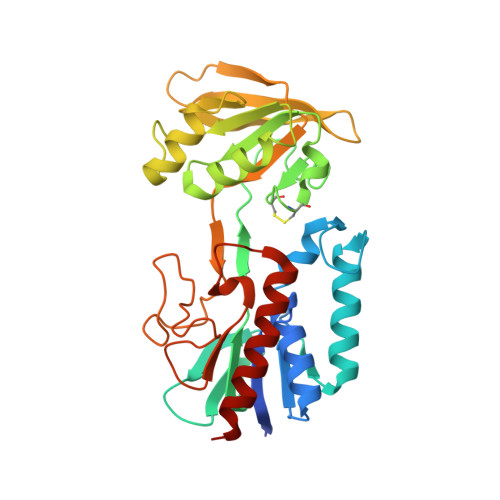Structural characterization of Giardia duodenalis thioredoxin reductase (gTrxR) and computational analysis of its interaction with NBDHEX.
Brogi, S., Fiorillo, A., Chemi, G., Butini, S., Lalle, M., Ilari, A., Gemma, S., Campiani, G.(2017) Eur J Med Chem 135: 479-490
- PubMed: 28477573
- DOI: https://doi.org/10.1016/j.ejmech.2017.04.057
- PubMed Abstract:
Giardia duodenalis is a microaerophilic parasite that colonizes the upper portions of the small intestine of humans. Giardia infection is a major contributor to diarrheal disease worldwide. Nitroheterocycles (e.g. metronidazole) or benzimidazoles (e.g. albendazole) are the most commonly used therapeutic agents. Unfortunately, their efficacy is reduced by low compliance or resistance phenomena. We recently discovered that the antitumoral drug 6-(7-nitro-2,1,3-benzoxadiazol-4-ylthio)hexanol (NBDHEX) is active against G. duodenalis trophozoites and its mode of action is linked to inhibition of thioredoxin reductase (gTrxR), a key component of Giardia redox system: gTrxR provides efficient defenses against reactive oxygen species (ROS), it is a target of 5-nitroimidazoles antiparasitic drugs and also contributes to their metabolism. However, the exact mechanism responsible for the gTrxR inhibition mediated by this chemical class of antigiardial compounds is yet to be defined. The definition of the structural determinants of activity against gTrxR could be important for the identification of novel drugs endowed with an innovative mode of action. With this aim, we solved the crystal structure of gTrxR and we analyzed in silico the binding mode of NBDHEX. The data presented herein could guide the development of NBDHEX derivatives tailored for selective inhibition of gTrxR as antigiardial agents.
Organizational Affiliation:
European Research Centre for Drug Discovery and Development (NatSynDrugs), Department of Biotechnology, Chemistry, and Pharmacy, Università di Siena via Aldo Moro 2, 53100 Siena, Italy.
















